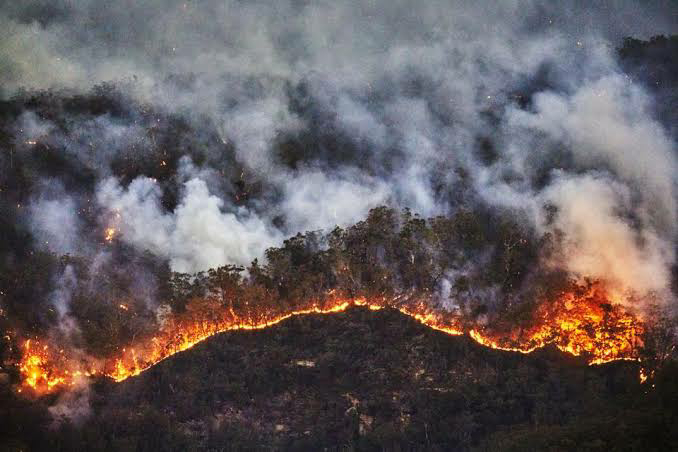Fire smoke
The composition of them Gaseous mixture "fire smoke" varies according to the fuel and conditions. A well-oxygenated, outdoor wood fire nay produce a very light smoke with relatively few chemicals. Although there are particulates in wood smoke capable of causing low-level inflammation, this type of exposure rarely requires medical attention. Toxic fire smoke, however, is the result of a fire when the fuel load is more complex (e.g plastics, artificial facbrics) or the oxygen supply us limited. Structure fires are usually the primary concern when we consider smoke inhalation, but toxic fire smoke is also created at trash bin/dumpster and automobile fires. Wildfire smoke can also be toxic if the burning area was recently sprayed with chemicals.
Chemicals are released from incomplete combustion and from the off-gassing of glues used in the manufacturing process.
Also contained within fire smoke are small Inhalable particles known as fines and ultrafine. These particles (less than 0.00001 mm in diameter) are less well-known to the public safety services but can be very damaging to health. Ultrafine particle concentration can be very high after fire suppression, even when there doesn't appear to be a significant amount of smoke in the room.
Acute vs Chronic Effects:-
Smoke exposure can injure the victim immediately (acute) or over a longer period of time (chronic/delayed). Victims trapped near the fire source may be exposed to hot and dense smoke with off-gassing chemicals including carbon monoxide (CO) and cyanide.
Often, these chemicals cause bronchospasm, sloughing of the epithelial lining of the airway, mucus secretion, and inflammation and surfactant inactivation. How quickly these symptoms manifest depends on the chemicals within the smoke and the intensity and duration of the exposure. Smoke inhalation care and transport to the nearest appropriate hospital.
In contrast, fire fighters working at the scene after the fire has been extinguished can be exposed to lower levels of these same chemicals and particulates. Some fire fighters may leave the scene with elevated but subclinical doses of CO or hydrogen cyanide (HCN). The cumulative exposure to chemicals and particulates over years of service can result in respiratory conditions, heart disease or cancer. The exact particulate exposure required to cause health issues cause cardiac toxicity. Tollbooth workers and boilermakers are routinely exposed to ultrafine particles and suffer worse forms of cardiac disease and arrythmia when compared to other occupations.
Click here👉 What happens in a smoke house?
Carbon Monoxide and hydrogen Cyanide:-
CO and HCN are both chemical ashyxiates commonly found in fire smoke, and exposure should be considered in every case of smoke inhalation. CO is produced when a carbon-containing material, such as wood, is burned and there isn't enough oxygen present to completely transform into carbon dioxide (CO2). It's also commonly found near burning hydrocarbon fuels (e.g., gasoline and diesel). Although the fire smoke or fuel fumes are easy to identify, CO itself is colourless, odourless, tasteless and initially non-irritating. Hemoglobin has a high affinity for CO and once bound, the new molecule (carboxyhemoglobin [COHh] is no longer capable of binding oxygen. Since oxygen dissolves poorly in blood plasma, high COHb levels result in poor oxygen-carrying capacity and hypoxemia.
HCN is a by-product of the combustion of materials such as green wood, tobacco, cotton, paper, wool and silk. When burned, these materials release nitrogen gas into the air. Hot fires in enclosed spaces can convert the nitrogen gas to small amounts of cyanide. Unlike CO that alters the blood capacity to transport oxygen, cyanide affects the cell and accumulates lactic acid and the intracellular pH drops.
You should assume that both CO and HCN are present in fire smoke and that fire victims that been poisoned by both, resulting in both oxygen transport and utilization issues. The immediate danger to life and health toxicity for cyanide is much lower (50ppm) when compared to CO (1200ppm), so firefighters should be extremely cautious about working in a smoky environment unless wearing self-contained breathing apparatus (SCBA).
Five major pollutants
EPA establishes an AQI for five major air pollutants regulated by the Clean Air Act. Each of these pollutants has a national air quality standard set by EPA to protect public health:
- ground-level ozone
- particle pollution (also known as particulate matter, including PM2.5 and PM10)
- carbon monoxide
- sulfur dioxide
- nitrogen dioxide
Who is at greatest risk from wildfire smoke?
- People who have heart or lung diseases, like heart disease, lung disease, or asthma, are comparatively at higher risk from wildfire smoke.
- Older adults are more likely to be affected by smoke. This may be due to their increased risk of heart and lung diseases.
- Children are more likely to be affected by health threats from smoke. Children’s airways are still developing and they breathe more air per pound of body weight than adults. Also, children often spend more time outdoors engaged in activity and play.
CLICK HERE👉How do smoke detectors work?




Comments